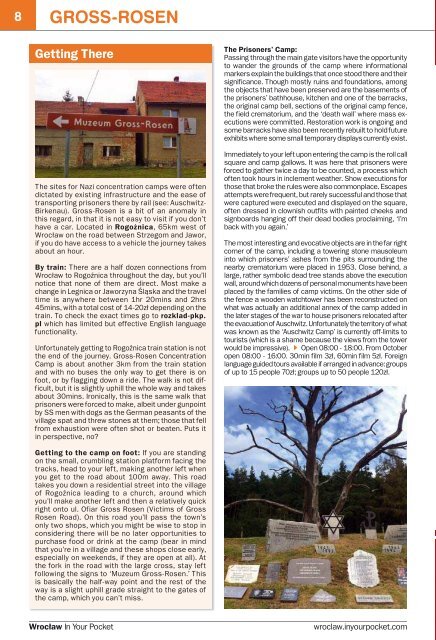You also want an ePaper? Increase the reach of your titles
YUMPU automatically turns print PDFs into web optimized ePapers that Google loves.
8<br />
GROSS-ROSEN<br />
Getting There<br />
The sites for Nazi concentration camps were often<br />
dictated by existing infrastructure and the ease of<br />
transporting prisoners there by rail (see: Auschwitz-<br />
Birkenau). Gross-Rosen is a bit of an anomaly in<br />
this regard, in that it is not easy to visit if you don’t<br />
have a car. Located in Rogożnica, 65km west of<br />
Wrocław on the road between Strzegom and Jawor,<br />
if you do have access to a vehicle the journey takes<br />
about an hour.<br />
By train: There are a half dozen connections from<br />
Wrocław to Rogoźnica throughout the day, but you’ll<br />
notice that none of them are direct. Most make a<br />
change in Legnica or Jaworzyna Śląska and the travel<br />
time is anywhere between 1hr 20mins and 2hrs<br />
45mins, with a total cost of 14-20zł depending on the<br />
train. To check the exact times go to rozklad-pkp.<br />
pl which has limited but effective English language<br />
functionality.<br />
Unfortunately getting to Rogoźnica train station is not<br />
the end of the journey. Gross-Rosen Concentration<br />
Camp is about another 3km from the train station<br />
and with no buses the only way to get there is on<br />
foot, or by flagging down a ride. The walk is not difficult,<br />
but it is slightly uphill the whole way and takes<br />
about 30mins. Ironically, this is the same walk that<br />
prisoners were forced to make, albeit under gunpoint<br />
by SS men with dogs as the German peasants of the<br />
village spat and threw stones at them; those that fell<br />
from exhaustion were often shot or beaten. Puts it<br />
in perspective, no?<br />
Getting to the camp on foot: If you are standing<br />
on the small, crumbling station platform facing the<br />
tracks, head to your left, making another left when<br />
you get to the road about 100m away. This road<br />
takes you down a residential street into the village<br />
of Rogoźnica leading to a church, around which<br />
you’ll make another left and then a relatively quick<br />
right onto ul. Ofiar Gross Rosen (Victims of Gross<br />
Rosen Road). On this road you’ll pass the town’s<br />
only two shops, which you might be wise to stop in<br />
considering there will be no later opportunities to<br />
purchase food or drink at the camp (bear in mind<br />
that you’re in a village and these shops close early,<br />
especially on weekends, if they are open at all). At<br />
the fork in the road with the large cross, stay left<br />
following the signs to ‘Muzeum Gross-Rosen.’ This<br />
is basically the half-way point and the rest of the<br />
way is a slight uphill grade straight to the gates of<br />
the camp, which you can’t miss.<br />
The Prisoners’ Camp:<br />
Passing through the main gate visitors have the opportunity<br />
to wander the grounds of the camp where informational<br />
markers explain the buildings that once stood there and their<br />
significance. Though mostly ruins and foundations, among<br />
the objects that have been preserved are the basements of<br />
the prisoners’ bathhouse, kitchen and one of the barracks,<br />
the original camp bell, sections of the original camp fence,<br />
the field crematorium, and the ‘death wall’ where mass executions<br />
were committed. Restoration work is ongoing and<br />
some barracks have also been recently rebuilt to hold future<br />
exhibits where some small temporary displays currently exist.<br />
Immediately to your left upon entering the camp is the roll call<br />
square and camp gallows. It was here that prisoners were<br />
forced to gather twice a day to be counted, a process which<br />
often took hours in inclement weather. Show executions for<br />
those that broke the rules were also commonplace. Escapes<br />
attempts were frequent, but rarely successful and those that<br />
were captured were executed and displayed on the square,<br />
often dressed in clownish outfits with painted cheeks and<br />
signboards hanging off their dead bodies proclaiming, ‘I’m<br />
back with you again.’<br />
The most interesting and evocative objects are in the far right<br />
corner of the camp, including a towering stone mausoleum<br />
into which prisoners’ ashes from the pits surrounding the<br />
nearby crematorium were placed in 1953. Close behind, a<br />
large, rather symbolic dead tree stands above the execution<br />
wall, around which dozens of personal monuments have been<br />
placed by the families of camp victims. On the other side of<br />
the fence a wooden watchtower has been reconstructed on<br />
what was actually an additional annex of the camp added in<br />
the later stages of the war to house prisoners relocated after<br />
the evacuation of Auschwitz. Unfortunately the territory of what<br />
was known as the ‘Auschwitz Camp’ is currently off-limits to<br />
tourists (which is a shame because the views from the tower<br />
would be impressive). Q Open 08:00 - 18:00. From October<br />
open 08:00 - 16:00. 30min film 3zł, 60min film 5zł. Foreign<br />
language guided tours available if arranged in advance: groups<br />
of up to 15 people 70zł; groups up to 50 people 120zł.<br />
Wrocław <strong>In</strong> <strong>Your</strong> <strong>Pocket</strong> wroclaw.inyourpocket.com
















